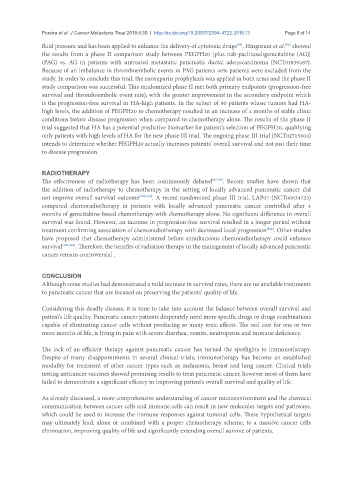Page 369 - Read Online
P. 369
Pereira et al. J Cancer Metastasis Treat 2018;4:30 I http://dx.doi.org/10.20517/2394-4722.2018.13 Page 9 of 14
fluid pressure and has been applied to enhance the delivery of cytotoxic drugs . Hingorani et al. showed
[95]
[96]
the results from a phase II comparison study between PEGPH20 [plus nab-paclitaxel/gemcitabine (AG)]
(PAG) vs. AG in patients with untreated metastatic pancreatic ductal adenocarcinoma (NCT01839487).
Because of an imbalance in thromboembolic events in PAG patients 40% patients were excluded from the
study. In order to conclude this trial, the enoxaparin prophylaxis was applied in both arms and the phase II
study comparison was successful. This randomized phase II met both primary endpoints (progression-free
survival and thromboembolic event rate), with the greater improvement in the secondary endpoint which
is the progression-free survival in HA-high patients. In the subset of 80 patients whose tumors had HA-
high levels, the addition of PEGPH20 to chemotherapy resulted in an increase of 4 months of stable clinic
conditions before disease progression when compared to chemotherapy alone. The results of the phase II
trial suggested that HA has a potential predictive biomarker for patient’s selection of PEGPH20, qualifying
only patients with high levels of HA for the new phase III trial. The ongoing phase III trial (NCT02715804)
intends to determine whether PEGPH20 actually increases patients’ overall survival and not just their time
to disease progression.
RADIOTHERAPY
The effectiveness of radiotherapy has been continuously debated [97-99] . Recent studies have shown that
the addition of radiotherapy to chemotherapy in the setting of locally advanced pancreatic cancer did
not improve overall survival outcome [100,101] . A recent randomized phase III trial, LAP07 (NCT00634725)
compared chemoradiotherapy in patients with locally advanced pancreatic cancer controlled after 4
months of gemcitabine-based chemotherapy with chemotherapy alone. No significant difference in overall
survival was found. However, an increase in progression-free survival resulted in a longer period without
treatment confirming association of chemoradiotherapy with decreased local progression . Other studies
[102]
have proposed that chemotherapy administered before simultaneous chemoradiotherapy could enhance
survival [103,104] . Therefore, the benefits of radiation therapy in the management of locally advanced pancreatic
cancer remain controversial .
CONCLUSION
Although some studies had demonstrated a mild increase in survival rates, there are no available treatments
to pancreatic cancer that are focused on preserving the patients’ quality of life.
Considering this deadly disease, it is time to take into account the balance between overall survival and
patient's life quality. Pancreatic cancer patients desperately need more specific drugs or drugs combinations
capable of eliminating cancer cells without producing so many toxic effects. The real cost for one or two
more months of life, is living in pain with severe diarrhea, vomits, neutropenia and immune deficiency.
The lack of an efficient therapy against pancreatic cancer has turned the spotlights to immunotherapy.
Despite of many disappointments in several clinical trials, immunotherapy has become an established
modality for treatment of other cancer types such as melanoma, breast and lung cancer. Clinical trials
testing anticancer vaccines showed promising results to treat pancreatic cancer, however most of them have
failed to demonstrate a significant efficacy in improving patient's overall survival and quality of life.
As already discussed, a more comprehensive understanding of cancer microenvironment and the chemical
communication between cancer cells and immune cells can result in new molecules targets and pathways,
which could be used to increase the immune responses against tumoral cells. These hypothetical targets
may ultimately lead, alone or combined with a proper chemotherapy scheme, to a massive cancer cells
elimination, improving quality of life and significantly extending overall survive of patients.

